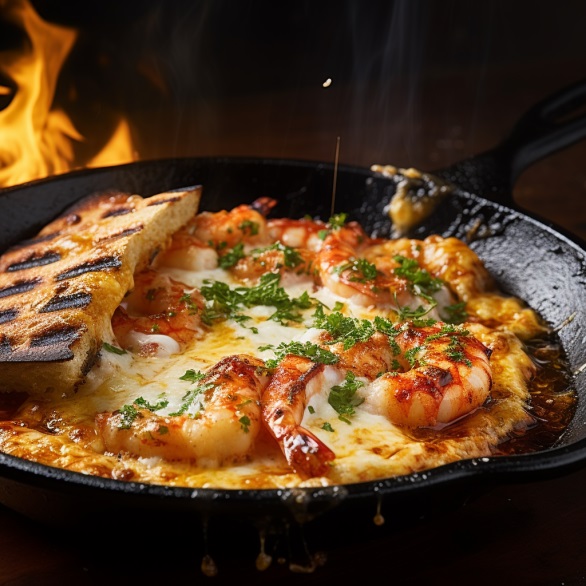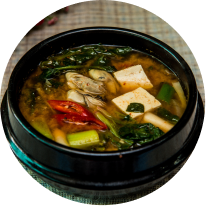Greek Saganaki: A Delicious Greek Appetizer
Introduction
Greek Saganaki is a popular Greek appetizer known for its sizzling presentation and rich flavors. Made with pan-seared Greek cheese, it is a favorite dish among Greek cuisine enthusiasts. The dish originated in Greece and has since gained worldwide recognition for its unique combination of crispy exterior and gooey interior. If you’re looking to explore more Greek recipes and culinary traditions, Cooking With Greek People’s website is the perfect place to start.

Greek cuisine is renowned for its Mediterranean flavors and emphasis on fresh, high-quality ingredients. Saganaki perfectly embodies these characteristics, making it a beloved dish in Greek culture. Whether you’re enjoying it as an appetizer or part of a mezze spread, Greek Saganaki is sure to delight your taste buds and transport you to the sunny shores of Greece.
What is Greek Saganaki?
Greek Saganaki is a traditional Greek appetizer made by pan-searing Greek cheese. The cheese is sliced into ½-inch thick pieces, coated in flour, and pan-fried until golden brown on both sides. This cooking method creates a crispy outer layer while allowing the cheese to melt on the inside, resulting in a delightful contrast of textures. The dish is typically cooked in a traditional, shallow, heavy-bottomed frying pan called “saganaki,” which gives it its name.
The preferred Greek cheeses for saganaki are kefalotyri, graviera, or kefalograviera. These cheeses have a distinct flavor and texture that is perfect for pan-searing. Kefalotyri is a hard cheese with a salty and tangy taste, while graviera is a semi-hard cheese with a slightly sweet and nutty flavor.
Kefalograviera is a combination of the two, offering a balance of sharpness and richness. If these specific Greek cheeses are not available, there are suitable substitutes. Kasseri, a semi-hard cheese with a tangy flavor, is a popular choice. Feta cheese, with its creamy and salty taste, can also be used. Another option is halloumi, a Cypriot cheese that has a unique ability to hold its shape when heated. These cheeses may not be traditional, but they still deliver the deliciousness of saganaki.
How to Make Greek Saganaki
Making Greek Saganaki is a simple and straightforward process that requires a few key ingredients and techniques. To start, slice the cheese into ½-inch thick pieces. Then, coat the cheese in flour, which helps create a crispy outer layer when pan-fried. Heat some olive oil in a pan over medium-high heat and add the cheese slices. Cook until golden brown on both sides, ensuring that the cheese is melted on the inside. The result is a mouthwatering appetizer that is perfect for sharing.
For those who enjoy a touch of drama, flambéing the saganaki is an option. This involves igniting the cheese with brandy or ouzo, a Greek anise-flavored liqueur. The flames quickly die down, leaving behind a caramelized and slightly smoky flavor. This fiery presentation adds excitement to the dining experience and impresses guests.
Here is an example to illustrate the process of making Greek Saganaki: Imagine you are preparing a Greek-inspired dinner party. As an appetizer, you decide to make saganaki using kefalotyri cheese. You slice the cheese into thick pieces, coat them in flour, and heat some olive oil in a saganaki pan.
Once the oil is hot, you add the cheese slices and cook them until golden brown on both sides. As the cheese sizzles in the pan, a mouthwatering aroma fills the air. You carefully remove the saganaki from the heat, and it is ready to be served. The crispy exterior and gooey interior of the cheese create a delectable appetizer that your guests are sure to enjoy.
Serving and Pairing Greek Saganaki
Greek Saganaki is traditionally served with lemon wedges and crusty bread. The tanginess of the lemon complements the richness of the cheese, creating a well-balanced flavor profile. Squeezing the lemon over the saganaki adds a burst of freshness and enhances the overall taste.
The crusty bread provides a satisfying crunch and acts as a vessel for scooping up the melted cheese. It can be enjoyed as part of a mezze spread or appetizer platter, alongside other Greek dishes like Greek meatballs, stuffed grape leaves, and tzatziki. The combination of these dishes creates a symphony of flavors that transport you to the sunny shores of Greece.
When it comes to pairing beverages with Greek Saganaki, there are several options to consider. A crisp and refreshing white wine, such as Assyrtiko or Moschofilero, complements the richness of the cheese. The acidity of the wine cuts through the creaminess, cleansing the palate with each sip. If you prefer beer, a light and citrusy wheat beer or a hoppy IPA can be a great choice. These beers provide a refreshing contrast to the richness of the saganaki.
Here’s an example to illustrate the serving and pairing of Greek Saganaki: Imagine you’re hosting a summer gathering with friends. You decide to serve Greek Saganaki as an appetizer. You present a sizzling plate of golden-brown cheese alongside lemon wedges and a basket of crusty bread. The guests eagerly reach for a slice of the saganaki, squeezing a lemon wedge over the top to enhance the flavors. They take a bite, savoring the crispy exterior and the creamy, melted cheese inside. As they enjoy the saganaki, you offer them glasses of Assyrtiko, a refreshing Greek white wine. The wine’s crispness and citrus notes complement the richness of the cheese, creating a delightful pairing. The combination of saganaki, lemon, and wine transports your guests to the vibrant streets of Greece, even if just for a moment.
The Flaming Saganaki Tradition
Flaming saganaki is a Greek-American custom that has become synonymous with Greek cuisine in many parts of the world. However, it is important to note that flambéing the saganaki is not necessary for serving and is not a part of the traditional Greek recipe. The tradition of flaming saganaki originated in 1968 at a Greek restaurant in Chicago’s Greektown based on a customer’s suggestion. The flames are quickly extinguished with a squeeze of lemon juice, adding a burst of citrus flavor to the dish. While the flaming saganaki adds a theatrical element to the dining experience, it is not essential to enjoy the deliciousness of Greek Saganaki.
Here’s an example to illustrate the tradition of flaming saganaki: Picture yourself dining at a Greek restaurant with a group of friends. As you peruse the menu, you notice saganaki listed as an appetizer. Intrigued by the description, you decide to order it. A short while later, the waiter arrives at your table with a sizzling plate of cheese. To your surprise, he pours a small amount of brandy over the cheese and ignites it, creating a fleeting but mesmerizing flame. The flames dance and flicker, captivating your attention and drawing the gaze of other diners nearby. As the flames subside, the waiter squeezes fresh lemon juice over the cheese, balancing the richness with a burst of citrus. The saganaki is then ready to be enjoyed. This theatrical presentation adds excitement to the dining experience and leaves a lasting impression on all who witness it.
Tips for Perfect Saganaki
To achieve the perfect saganaki, it is important to ensure that the pan is very hot before adding the cheese. This helps create a golden crust on the outside while keeping the inside soft and gooey. Using thicker cheese slices also helps maintain the desired texture. Thinner slices may melt too quickly and become too soft, while thicker slices provide a better balance of crispy and melted cheese.
Following a detailed recipe and selecting the right cheese are crucial steps in making the perfect saganaki. Different cheeses have different melting points and textures, so it is important to choose the right cheese for the desired result. Additionally, using high-quality ingredients, such as Greek olive oil and fresh lemon juice, can elevate the flavors of the dish.
If you’re looking for expert tips and troubleshooting, Cooking With Greek People offers valuable guidance for making the perfect saganaki. From selecting the right cheese to achieving the ideal level of crispiness, their recipes and tips will help you master the art of saganaki.
Here’s an example to illustrate the importance of following tips for perfect saganaki: Imagine you’re a home cook who loves Greek cuisine. You’ve tried making saganaki before but struggled to achieve the desired result. The cheese turned out too soft and mushy, or it became overly oily. Determined to make the perfect saganaki, you seek advice from fellow food enthusiasts online. They recommend ensuring that the pan is very hot before adding the cheese, as this helps create a crispy exterior while keeping the inside soft and gooey. You also learn that using thicker cheese slices can prevent the cheese from melting too quickly and becoming too soft. Armed with this knowledge, you give saganaki another try. This time, you carefully follow the tips and select the right cheese. The result is a plate of beautifully golden saganaki with a perfect balance of crispy and melted cheese. With each bite, you can taste the success of your efforts and enjoy the delightful flavors of Greek Saganaki.
Health Benefits of Greek Saganaki
Greek Saganaki, like many Greek dishes, offers health benefits when enjoyed in moderation. It is a good source of protein and calcium, which are essential for strong bones and muscles. The use of fresh ingredients and Mediterranean flavors in Greek cuisine also contributes to a healthy diet. The incorporation of olive oil, lemon juice, and herbs adds antioxidants and anti-inflammatory properties to the dish.
However, it is important to keep in mind that saganaki is a higher-fat dish due to the cheese and frying process. As with any indulgent food, moderation is key. Enjoying saganaki as part of a well-balanced diet allows you to savor its flavors while maintaining a healthy lifestyle.
Here’s an example to illustrate the health benefits of Greek Saganaki: Imagine you’re conscious of maintaining a balanced and nutritious diet. However, you also want to indulge in the flavors of Greek cuisine. You discover that Greek Saganaki, when enjoyed in moderation, can be a part of a healthy lifestyle. The saganaki’s cheese provides a good source of protein and calcium, important nutrients for your bones and muscles. Additionally, the use of fresh ingredients like olive oil, lemon juice, and herbs adds antioxidants and anti-inflammatory properties to the dish. By incorporating saganaki into your diet alongside other nutritious foods, you can enjoy its rich flavors while still nourishing your body.
Variations of Saganaki
Besides the traditional cheese saganaki, there are other variations of this dish that showcase the versatility of Greek cuisine. One popular variation is shrimp saganaki, which combines succulent shrimp with a flavorful tomato and ouzo sauce. The shrimp is cooked in the saganaki pan, absorbing the rich flavors of the sauce. The result is a mouthwatering combination of seafood, tomatoes, herbs, and spices.
For those who prefer a vegetarian option, mushroom saganaki is a delicious choice. Sliced mushrooms are sautéed with garlic, olive oil, and herbs, creating a savory and satisfying dish. The earthy flavors of the mushrooms are enhanced by the saganaki cooking method, resulting in a dish that is bursting with umami.
If you’re interested in exploring different saganaki variations, Cooking With Greek People’s website offers a variety of recipes to suit your taste. From seafood to vegetables, their collection of saganaki recipes will inspire you to get creative in the kitchen and discover new flavors.
Here’s an example to illustrate the variations of saganaki: Imagine you’re attending a Greek-themed party, and the host has prepared a delightful spread of saganaki variations. On the table, you see not only the classic cheese saganaki but also plates of shrimp saganaki and mushroom saganaki. You take a bite of the shrimp saganaki and taste the succulent shrimp coated in a flavorful tomato and ouzo sauce. The sweetness of the tomatoes and the anise flavor of the ouzo perfectly complement the shrimp. You then try the mushroom saganaki and savor the earthy flavors of the sautéed mushrooms, enhanced by the saganaki cooking method. Each variation provides a unique and delicious twist on the traditional saganaki, showcasing the versatility of Greek cuisine.
The Cultural Significance of Saganaki
Saganaki holds cultural significance as a beloved Greek appetizer associated with festive occasions and family gatherings. It represents Greek hospitality and the importance of food in Greek culture. In Greece, sharing a meal is a cherished tradition that brings people together and strengthens social bonds. Saganaki, with its sizzling presentation and delicious flavors, is a dish that is often enjoyed in the company of loved ones.
Cooking With Greek People is committed to preserving Greek culinary traditions and sharing them with the world. Through their website and recipes, they provide a taste of Greek culture and invite people to experience the warmth and hospitality that Greek cuisine embodies. Whether you’re preparing saganaki for a special celebration or a casual gathering, you can be sure that it will leave a lasting impression on your guests.
Here’s an example to illustrate the cultural significance of saganaki: Imagine you’re attending a Greek wedding celebration. As you enter the reception venue, you’re greeted by the aroma of sizzling saganaki. The sound of laughter and joyful conversations fills the air as guests gather around the saganaki station, eagerly awaiting their turn to indulge in this beloved Greek appetizer. The bride and groom, surrounded by their loved ones, join in the festivities and share plates of saganaki with their guests. The saganaki becomes a centerpiece of the celebration, symbolizing Greek hospitality and the importance of food in bringing people together. As you savor each bite of the saganaki, you can feel the love and warmth that permeate the air, creating memories that will last a lifetime.
Conclusion
Greek Saganaki is a delicious Greek appetizer that has gained popularity for its sizzling presentation and rich flavors. Whether you’re a fan of the traditional cheese saganaki or want to explore unique variations, Cooking With Greek People’s website is your go-to source for authentic Greek recipes and culinary traditions. Visit their website at https://cookingwithgreekpeople.com/ to discover more about Greek cuisine and embark on a culinary journey through the flavors of Greece. From the simplicity of the classic saganaki to the creativity of its variations, Greek Saganaki offers a taste of Greece that will leave you craving more. So gather your ingredients, heat up your saganaki pan, and get ready to experience the deliciousness of Greek cuisine in your own kitchen.
follow up the Saganaki with some Beef Souvlaki














